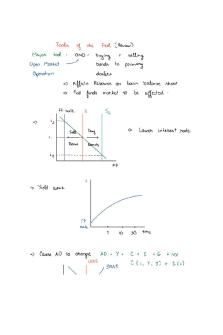Qualitative and Quantitative tools of monetary policy PDF

| Title | Qualitative and Quantitative tools of monetary policy |
|---|---|
| Author | Jerin Joy |
| Course | Macroeconomics |
| Institution | Symbiosis International University |
| Pages | 2 |
| File Size | 72.8 KB |
| File Type | |
| Total Downloads | 87 |
| Total Views | 216 |
Summary
Class Notes...
Description
Qualitative and Quantitative tools of monetary policy
Monetary policy plays an important role in the development of the country. If the required money supply for the economy is not available in the market, it leads to a decline in investment in the economy. On the other hand, if the money supply in the economy is more than what is required, then the poor section of the economy will suffer because the price of essential commodities will rise. RBI implements the monetary policy's Quantitative and Qualitative instruments to achieve economic goals. Quantitative Methods: Bank Rate Policy - lending rate at which commercial banks borrow from the RBI without providing any security. - Has a direct impact on the lending rates to customers - 4.25% CRR (Cash Reserve Ratio) -
percentage of commercial bank's net demand and time liability that commercial banks have to maintain with the RBI at all times. 3.50%
SLR (Statutory Liquidity Ratio) Repo Rate -
percentage of reserves to be maintained in the form of gold and foreign securities. 18.00% rate at which commercial banks borrow money by selling their securities to the RBI to maintain liquidity. 4.00%
Reverse Repo Rate - The interest earned by commercial banks for parking their excess funds with RBI - 3.35% Open Market Operations (OMO) - The sale and purchase of security in the long run/short run by the RBI in the money market is known as open market operations. - When the RBI feels that there is excess liquidity in the market, it sells securities, thereby sucking out the rupee liquidity.
-
Similarly, when the liquidity conditions are tight, the RBI may buy securities from the market, thereby releasing liquidity into the market.
Qualitative Methods Regulation of Consumer Credit - During inflation, this method is followed to control excess spending of the consumers. - Generally the hire purchase facilities or installment methods are used to reduce to the minimum to curb the expenditure on consumption. - On the contrary, during depression period, more credit facilities are allowed so that consumer may spend more and more to pull the economy out of depression. Direct Action This method is adopted when some commercial banks do not co-operate with the central bank in controlling the credit. Thus, central bank takes direct action against the defaulter. The central bank may take direct action in a number of ways as under. It may change rates over and above the bank rate. It may refuse rediscount facilities to those banks who are not following its directions. Deny financial accommodation -
Rationing of the credit: Under this method, the central bank fixes a limit for the credit facilities to commercial banks. Being the lender of the last resort, central bank rations the available credit among the applicants. Generally, rationing of credit is done by the following four ways. 1. Central bank can refuse loan to any bank. 2. Central bank can reduce the amount of loans given to the banks. 3. Central bank can fix quota of the credit. 4. Central bank can determine the limit of the credit granted to a particular industry or trade. -...
Similar Free PDFs

Chapter 16 Monetary Policy
- 3 Pages

Chapter-5 - Monetary policy
- 11 Pages

A) Monetary policy - pdf
- 4 Pages
Popular Institutions
- Tinajero National High School - Annex
- Politeknik Caltex Riau
- Yokohama City University
- SGT University
- University of Al-Qadisiyah
- Divine Word College of Vigan
- Techniek College Rotterdam
- Universidade de Santiago
- Universiti Teknologi MARA Cawangan Johor Kampus Pasir Gudang
- Poltekkes Kemenkes Yogyakarta
- Baguio City National High School
- Colegio san marcos
- preparatoria uno
- Centro de Bachillerato Tecnológico Industrial y de Servicios No. 107
- Dalian Maritime University
- Quang Trung Secondary School
- Colegio Tecnológico en Informática
- Corporación Regional de Educación Superior
- Grupo CEDVA
- Dar Al Uloom University
- Centro de Estudios Preuniversitarios de la Universidad Nacional de Ingeniería
- 上智大学
- Aakash International School, Nuna Majara
- San Felipe Neri Catholic School
- Kang Chiao International School - New Taipei City
- Misamis Occidental National High School
- Institución Educativa Escuela Normal Juan Ladrilleros
- Kolehiyo ng Pantukan
- Batanes State College
- Instituto Continental
- Sekolah Menengah Kejuruan Kesehatan Kaltara (Tarakan)
- Colegio de La Inmaculada Concepcion - Cebu












